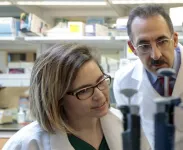TU Graz identifies bacterium that protects rice plants against diseases
Bacterium inside the seed can lead to complete resistance to a particular pathogen and is naturally transmitted from one plant generation to another
2021-01-11
(Press-News.org) Rice is the staple food of about half the world's population. The cultivation of the rice plant is very water-intensive and, according to the German aid organization Welthungerhilfe, around 15 per cent of rice is grown in areas with a high risk of drought. Global warming is therefore becoming increasingly problematic for rice cultivation, leading more and more often to small harvests and hunger crises. Crop failures caused by plant pathogens further aggravate the situation. Here, conventional agriculture is trying to counteract this with pesticides, which are mostly used as a precautionary measure in rice cultivation. The breeding of resistant plants is the only alternative to these environmentally harmful agents - and currently only moderately successful. If the plants are resistant to one pathogen thanks to their breeding, they are usually more susceptible to other pathogens or are less robust under adverse environmental conditions.
Bacterium confers pathogen resistance
For this reason, an international research group which includes the Institute of Environmental Biotechnology at Graz University of Technology has been studying the microbiome of rice plant seeds for some time now in order to establish correlations between plant health and the occurrence of certain microorganisms. The group has now achieved a major breakthrough. They identified a bacterium inside the seed that can lead to complete resistance to a particular pathogen and is naturally transmitted from one plant generation to another. The findings published in the scientific journal Nature Plants provide a completely new basis for designing biological plant protection products and additionally reducing harmful biotoxins produced by plant pathogens.
The microbiome of rice
In conventional rice cultivation in the Chinese province of Zhejiang, it was observed that one genotype of rice plants (cultivar Zhongzao 39) sometimes develops resistance to the plant pathogen Burkholderia plantarii. This pathogen leads to crop failures and also produces a biotoxin that can cause organ damage and tumours in persistently exposed humans and animals. "Up to now, the sporadic resistance of rice plants to this pathogen could not be explained," says Tomislav Cernava from the Institute of Environmental Biotechnology at Graz University of Technology. Together with the luminary of microbiome research and Institute head, Gabriele Berg, and his institute colleague Peter Kusstatscher, Cernava has been investigating the microbiome of rice seeds from different cultivation regions in detail in the context of a collaboration with Zhejiang University (Hangzhou) and Nanjing Agricultural University in China as well as with the Japanese Hokkaido University in Sapporo.
Bacterial composition as a decisive factor
The scientists found that the resistant plants have a different bacterial composition inside the seeds than the disease-susceptible plants. The bacterial genus Sphingomonas in particular was found significantly more often in resistant seeds. The researchers therefore isolated bacteria of this genus from the seeds and identified the bacterium Sphingomonas melonis as the responsible agent for disease resistance. This bacterium produces an organic acid (anthranilic acid), which inhibits the pathogen and thereby renders it harmless. "This also works when the isolated Sphingomonas melonis is applied to non-resistant rice plants. This automatically makes them resistant to the plant pathogen Burkholderia plantarii," explains Tomislav Cernava. In addition, the bacterium establishes itself in certain rice genotypes and is then passed on naturally from one plant generation to the next. "The potential of this finding is enormous. In the future, we will be able to use this strategy to reduce pesticides in agriculture and at the same time achieve good crop yields," emphasizes Cernava.
INFORMATION:
This research is anchored in the Field of Expertise "Human & Biotechnology", one of five strategic foci of Graz University of Technology.
Details of the original publication:
Bacterial seed endophyte shapes disease resistance in rice.
Haruna Matsumoto, Xiaoyan Fan, Yue Wang, Peter Kusstatscher, Jie Duan, Sanling Wu, Sunlu Chen, Kun Qiao, Yiling Wang, Bin Ma, Guonian Zhu, Yasuyuki Hashidoko, Gabriele Berg, Tomislav Cernava, Mengcen Wang. Nature Plants, January 2021. DOI: 10.1038/s41477-020-00826-5
https://www.nature.com/articles/s41477-020-00826-5
Articles on previous results of the Institute's microbiome research:
Minimizing post-harvest food losses
https://www.tugraz.at/en/tu-graz/services/news-stories/tu-graz-news/singleview/article/lebensmittelverluste-nach-der-ernte-minimieren0/
The microbiome: Our planet's tiny engine
https://www.tugraz.at/en/tu-graz/services/news-stories/planet-research/singleview/article/mikrobiom-der-winzige-motor-unseres-planeten0/
Germ-free hatching eggs: An alternative to the usual formaldehyde
https://www.tugraz.at/en/tu-graz/services/news-stories/tu-graz-news/singleview/article/germ-free-hatching-eggs-an-alternative-to-formaldehyde-application/
Excessive hygiene promotes resistance to antibiotics
https://www.tugraz.at/en/tu-graz/services/news-stories/planet-research/singleview/article/uebertriebene-hygiene-foerdert-antibiotikaresistenz0/
The origin of pandemics in the microbiome
https://www.tugraz.at/en/tu-graz/services/news-stories/tu-graz-news/singleview/article/den-ursprung-von-pandemien-im-mikrobiom0/
[Attachments] See images for this press release:

ELSE PRESS RELEASES FROM THIS DATE:
2021-01-11
Seeking to understand why COVID-19 is able to suppress the body's immune response, new research from the USC Leonard Davis School of Gerontology suggests that mitochondria are one of the first lines of defense against COVID-19 and identifies key differences in how SARS-CoV-2, the virus that causes COVID-19, interacts with mitochondrial genes when compared to other viruses.
These differences offer possible explanations as to why older adults and people with metabolic dysfunction have more severe responses to COVID-19 than other individuals, and they also provide a starting point for more targeted experiments that may help identify therapeutics, said senior author Pinchas Cohen, professor of gerontology, ...
2021-01-11
Our bodies often dispatch stem cells to mend or replace biological damage, but how these repair agents make their way through dense tissue to arrive at the scene had been a mystery. "How stem cells squeeze through tissue openings a hundred to a thousand times smaller than themselves had been a perplexing question," says Ovijit Chaudhuri, professor of mechanical engineering.
In an article published in the Jan. 8 edition of Science Advances, Chaudhuri and colleagues reveal that stem cells use their nucleus - a large, stiff organelle within the cell - as a means of propulsion.
Their discovery was surprising because scientists had thought cells would have particular ...
2021-01-11
(St. Louis) - A new study by investigators at the Shriners Hospital for Children -- St. Louis suggests the damaging effects of obesity are not due to body weight but rather come from something much smaller - biochemical signals released by fat cells.
The study focuses on the link between overweight or obesity and the development of osteoarthritis, a painful disease of the joints. The investigation was led by Dr. Farshid Guilak, director of the St. Louis Shriners Hospital Research Center.
"We've shown here that it's not overloading of the joints that is responsible for osteoarthritis, but, more likely, a factor given off by fat cells that makes cartilage susceptible to degeneration," ...
2021-01-11
ATLANTA AND TAMPA, FLA. - JANUARY 11, 2021 - A new study suggests a link between toxoplasma gondii (T. gondii) infection and the risk of glioma, a type of brain cancer, in adults. The report, appearing in the International Journal of Cancer, finds that people who have glioma are more likely to have antibodies to T. gondii (indicating that they have had a previous infection) than a similar group that was cancer free.
For the study, investigators led by James Hodge, JD, MPH and Anna Coghill, PhD examined the association between T. gondii antibodies measured several years before the cancer ...
2021-01-11
Scientists at Dana-Farber Cancer Institute and the Centers for Disease Control and Prevention have uncovered new evidence of the potential health risks of chemicals in tobacco and marijuana smoke.
In a study published online today by END ...
2021-01-11
Around 1085 AD, along the southern rim of Northern Arizona's elevated Colorado Plateau, a volcano erupted, forever changing ancient Puebloan fortunes and all nearby life. Among the 600 or so volcanoes that dot the landscape of the San Francisco volcanic fields, this one blew. It was the very first (and last) eruption for what came to be known as Sunset Crater, aptly named for its multi-hued, 1,000-foot-tall cinder cone.
Today, ASU School of Earth and Space Exploration scientist Amanda Clarke and her team have been working to solve the mysterious root cause of the Sunset Crater eruption and any lessons learned to better understand the threats similar ...
2021-01-11
Fieldwork led by Dr Eleanor Scerri, head of the Pan-African Evolution Research Group at the Max Planck Institute for the Science of Human History in Germany and Dr Khady Niang of the University of Cheikh Anta Diop in Senegal, has documented the youngest known occurrence of the Middle Stone Age. This repertoire of stone flaking methods and the resulting tools includes distinctive ways of producing sharp flakes by carefully preparing nodules of rock, some of which were sometimes further shaped into tool forms known as 'scrapers' and 'points.' Middle Stone Age finds most commonly occur in the African record between around 300 thousand and 30 thousand years ago, after which point ...
2021-01-11
Researchers have taken an important step forward in developing a controlled human infection model to test leishmaniasis vaccines.
The University of York-led study identified and characterised a new strain of Leishmania parasite that will form the basis of a new controlled human infection model for the disease which is transmitted by the bite of sand flies. The team then produced the parasite to the standards required for use in human clinical studies.
The use of controlled human infection models has already proved invaluable in accelerating vaccine development for cholera, malaria, typhoid, ...
2021-01-11
Conditions are ripe for transforming the U.S. mental health care system, with scientific advances, the growth of Medicaid and political consensus on the importance of improving mental health creating the possibility that goals once thought out of reach may be possible, according to a new RAND Corporation study.
Broad changes will be needed to improve how Americans receive mental health care, such as integrating behavioral health care into general health care settings, providing supportive housing to the homeless and promoting comprehensive mental health education.
Federal mental health parity legislation is one recent promising development that aims to put ...
2021-01-11
Human papillomavirus (HPV) can infect the mouth and throat to cause cancers of the oropharynx. A new study published early online in END ...
LAST 30 PRESS RELEASES:
[Press-News.org] TU Graz identifies bacterium that protects rice plants against diseases
Bacterium inside the seed can lead to complete resistance to a particular pathogen and is naturally transmitted from one plant generation to another






